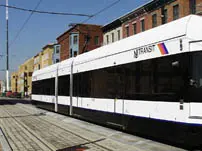Everybody loves the sound of a train in the distance, according to Paul Simon. Except if you live on Essex Street in Jersey City. While the much-anticipated Hudson-Bergen Light Rail will certainly make life happier for commuters, many residents living with the system’s tracks in their front and back yards are not whistling the same tune. During the testing of the billion-dollar transit system, homeowners along Essex Street have endured sleepless nights and inconveniences due to the loud noises and heavy vibration the Light Rail Vehicles (LRV) create, they say. Last week, Essex Street, which is lined with row homes that date back to 1850, was fitted with high-tech microphones and vibration detectors during a scheduled testing of the Light Rail system. Concerned residents clotted the sidewalks alongside engineers from NJ Transit and 21st Century Rail, the company that designed and built the futuristic trolley system, as a Jersey City Police Officer clocked the speed of each passing LRV. Many residents have filed complaints that tell of squealing brakes, booming air horns, loudspeakers announcing trolley stops and rumbling that shakes silverware in their drawers. “You can feel it through the whole house,” said Gale Morrison, who lives in a historic brownstone on Essex Street. “We understand the need for trains like this, but to a point. These are not people-friendly.” Other complaints have living room discussions muted by passing trains. One car in particular, 2016B, is “off the charts on vibration,” one resident said. The train is riding on wheels that have not yet been rounded, according to a NJ Transit engineer on site for the testing. The wobbly wheels make the vibrations increase. “They somehow forgot that wheels are supposed to be circular,” one resident mused from the sidewalk. But according to NJ Transit, that is precisely why the LRVs must be run continuously before they are open to the public. Kinks and imperfections must be worked out before passengers are permitted to ride. Arthur Connolly, another Essex Street homeowner, said that the trains being monitored last week were traveling much slower than the ones that wake him up at night. “When the cars speed, that’s when you hear the thumping of the wheels and the squealing of the brakes,” Connolly said. Sensitive seismographs, popularly used to measure the vibrations given off by earthquakes, were placed in two locations on Essex Street. The devices calculate vibration in time intervals, in order to record the approach, pass-by and departure of each moving Light Rail car. The same procedure was followed in measuring the noise each car emitted as it passed state-of-the-art microphones. Hefty hefty hefty Standing on a curb during the lengthy examination, a police officer clocked the passing LRVs with a radar gun. The speed of the trains never exceeded 14 miles per hour. The data, collected on-site by a team of engineers and scientists, will be sent to a location where it will be analyzed and determined if in fact the LRVs are too loud. Similar testing was done in 1996 when the Light Rail was in its very early stages. Before tracks were laid, passing busses travelling the Light Rail route were studied. Each LRV weighs in at a hefty 90,000 pounds, as compared to the feathery 4,000 pounds that an average automobile weighs. The tremendous poundage passing their homes has woken many residents from sleep as the cars roared through the night. Light Rail safety and mechanical testing has gone on 24 hours a day. “You need human-scale cars,” Morrison said. “You have to do it right.” NJ Transit officials, who are very much aware of the Essex Street complaints, said that they empathize with the residents. Nick Marton, the transportation company’s environmental director, said that they will assess the results of the study and look to improve where it is lacking. The study will be complete and revealed to the public in about two months. The Light Rail is scheduled to officially open to paying passengers sometime in April. The trains were originally slated to begin service between Bayonne and Exchange Place in March, but the date was eventually pushed back to April to allow for further testing. Once open, the system will expand to include service north to Newport and on to Hoboken. A second wing will stretch inland towards Journal Square as part of an additional phase in the making.
Our Digital Archive from 2000 – 2016
